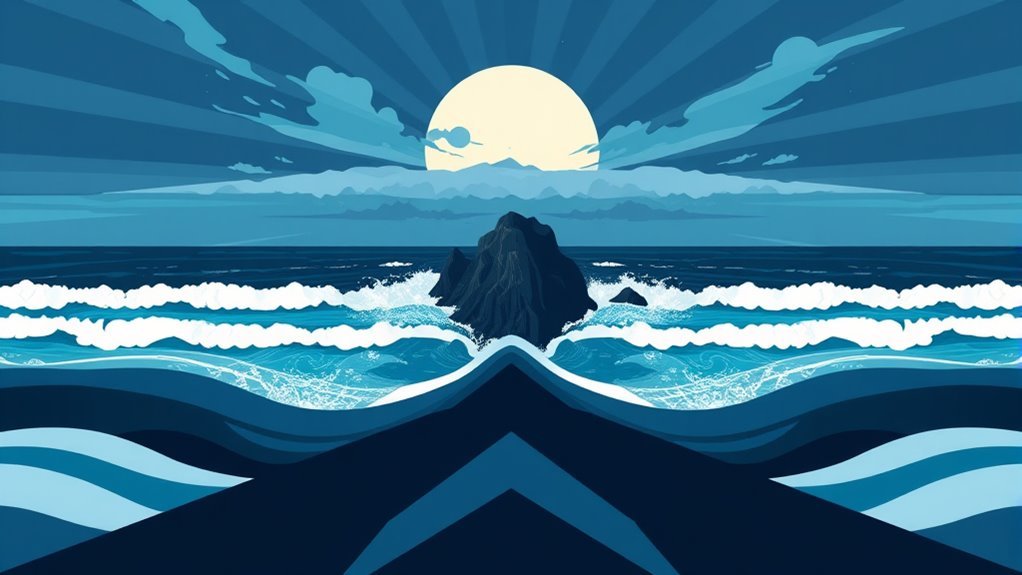Squalls form through the interplay of temperature gradients and the interaction of air masses. Warm air rises over cooler air, creating turbulence and instability. This movement generates updrafts and strong winds. Geographical influences, such as proximity to water and topography, further improve squall intensity. Sudden changes in wind speed and direction lead to intense precipitation events. Understanding these dynamics provides deeper insight into the behavior and impact of squalls in various weather patterns.
Main Points
- Squalls form when warm air rises over cooler air, creating instability and strong updrafts that enhance precipitation potential.
- The interaction of different air masses generates turbulence and vertical wind shear, leading to sudden changes in wind direction and speed.
- Geographical features, such as proximity to water and elevation changes, influence moisture availability and temperature gradients essential for squall formation.
- Orographic lift occurs when air is forced over raised terrains, which can intensify squall conditions and lead to localized precipitation events.
- Squalls often result in abrupt shifts in air mass, causing rapid temperature drops and localized downdrafts that contribute to intense wind and precipitation changes.
The Basics of Squalls: Definition and Characteristics
Although often brief, squalls are noteworthy weather phenomena defined by sudden increases in wind speed and intense precipitation. Typically associated with thunderstorms, squalls can occur unexpectedly, catching individuals off guard.
Their defining characteristics include sharp gusts of wind that may exceed 30 knots, accompanied by heavy rainfall, sometimes leading to reduced visibility and hazardous conditions. The duration of a squall is generally short-lived, often lasting only a few minutes to half an hour.
Squalls can also manifest in various forms, such as cold fronts or lines of convection, contributing to their diverse nature. The intensity of the wind and rain can vary greatly, resulting in localized impacts on both land and sea.
Sailors and outdoor enthusiasts are particularly vulnerable to squalls, necessitating awareness of weather conditions. Understanding the basic characteristics of squalls is essential for preparedness and safety during sudden weather changes.
The Role of Temperature Gradients in Squall Formation

Temperature gradients play a significant role in the formation of squalls by influencing air stability and movement. Variations in temperature between different layers of the atmosphere create conditions that can lead to the rapid development of squall lines.
When warm air rises over cooler air, it can cause turbulence and instability, essential for squall formation.
Key factors related to temperature gradients include:
- Warm, moist air rising and cooling, which can lead to condensation.
- Cooler air acting as a denser barrier, forcing warm air upwards.
- Instability created by sharp temperature differences, resulting in strong updrafts.
- Vertical wind shear, influenced by temperature differences, enhancing storm development.
- Enhanced precipitation potential, leading to sudden downpours typical of squalls.
Understanding these dynamics is imperative for predicting squalls and their associated weather phenomena.
Interactions Between Cold and Warm Air Masses
When warm and cold air masses converge, the resulting interactions can lead to the formation of squalls. The warm air, being less dense, rises above the cold air, which is denser and tends to remain at lower altitudes. This upward movement creates instability, often resulting in the development of cumulus clouds and, eventually, larger storm systems. As the warm air cools, moisture condenses, forming precipitation that can intensify rapidly.
Furthermore, the collision between these contrasting air masses generates turbulence and wind shear, which can improve the development of squall lines. This turbulence can lead to sudden changes in wind direction and speed, contributing to the squall's intensity.
The dynamics of these interactions are essential for understanding squall behavior, as they dictate the amount of energy available for storm development and the potential for severe weather phenomena, such as heavy rain and strong winds.
Geographical Influences on Squall Development

Geographical features play an essential role in the development of squalls, as the terrain can greatly influence weather patterns and air movement. Various environments contribute to the conditions necessary for squall formation.
For instance, coastal areas, valleys, and mountainous regions can create unique settings that boost squall intensity and frequency.
Key geographical influences on squall development include:
- Proximity to Water Bodies: Oceans and large lakes can provide moisture, fueling squall activity.
- Elevation Changes: Higher altitudes may lead to rapid temperature changes, triggering squalls.
- Land Use: Urban areas can create heat islands, affecting local wind patterns.
- Surrounding Vegetation: Forests and fields can alter airflow, impacting squall dynamics.
- Prevailing Winds: Direction and strength of winds can be shaped by geographical features, influencing squall paths.
Understanding these influences is critical for predicting squall occurrences.
The Impact of Topography on Wind Patterns
Topography plays a vital role in shaping wind patterns, particularly through the influence of mountains and valleys.
Raised terrains can improve wind speeds as air flows over peaks, while valleys can create channels that direct wind in specific directions.
Understanding these interactions is fundamental for comprehending how squalls might form and intensify in different geographical settings.
Mountain Effects on Winds
As air flows over mountainous regions, the interaction between the terrain and wind patterns creates unique atmospheric phenomena.
The presence of mountains greatly alters wind behavior, resulting in various effects that can influence local weather conditions. These effects include:
- Orographic Lift: Air is forced to rise over mountains, cooling and potentially leading to precipitation.
- Wind Shadows: Areas on the leeward side experience reduced wind intensity and drier conditions.
- Channeling Effects: Valleys can funnel winds, increasing their speed.
- Turbulence Generation: Irregular terrain can create chaotic wind patterns and eddies.
- Temperature Inversions: Mountains can trap cooler air in valleys, affecting local climate and air quality.
Understanding these dynamics is essential for predicting weather patterns in mountainous regions.
Valley Wind Channels
Valley wind channels serve as conduits for air movement, greatly altering local wind patterns. These channels, formed by the surrounding topography, aid the flow of air between raised regions, creating distinct wind behaviors.
In valleys, air often accelerates due to the constriction caused by the terrain, leading to stronger winds compared to adjacent areas. During the day, warmer air rises, and cooler air from the valley descends, establishing a predictable cycle that can influence local weather conditions.
At night, this pattern can reverse, with cold air pooling in the valley and creating calm conditions. Understanding these dynamics is essential for predicting weather phenomena, including squalls, as they can intensify due to the localized wind effects that valleys produce.
Squalls and Their Effects on Weather Systems
Squalls considerably impact weather systems, particularly in marine environments where sudden changes can disrupt activities.
They also play an important role in influencing temperature variations and are often linked to various precipitation events.
Understanding these effects is vital for predicting weather patterns and ensuring safety in affected areas.
Impact on Marine Activities
Sudden and intense weather phenomena, such as squalls, greatly impact marine activities. These unpredictable events can disrupt navigation, fishing, and recreational boating, posing considerable risks to both vessels and crew.
The rapid onset of strong winds and heavy rain can create hazardous conditions, leading to potential accidents at sea.
- Increased risk of capsizing for small boats
- Reduced visibility affecting navigation accuracy
- Sudden changes in wind direction complicating sailing
- Impact on fishing operations due to safety concerns
- Delays in marine transport and shipping schedules
Understanding the effects of squalls is vital for mariners to guarantee safety and effective decision-making during these unpredictable weather events.
Proper forecasting and preparedness can mitigate some of these risks.
Influence on Temperature Changes
As atmospheric conditions shift, squalls can prominently influence temperature changes within their surrounding weather systems. These sudden and intense wind events often bring abrupt shifts in air mass, leading to rapid fluctuations in temperature.
When a squall front moves through an area, it typically replaces warm air with cooler, denser air, resulting in a considerable drop in temperature. This cooling effect can disrupt local thermal profiles and alter atmospheric stability.
Additionally, the intensity of squalls can create localized downdrafts, enhancing the downward movement of cooler air. Such temperature changes can have cascading effects on regional weather patterns, influencing everything from local microclimates to broader climatic conditions.
Understanding these dynamics is essential for predicting the behavior of squalls and their impact on the environment.
Relationship to Precipitation Events
The relationship between squalls and precipitation events is notable, as these intense weather phenomena often lead to sudden bursts of rain or other forms of precipitation.
Squalls are typically defined by sharp changes in wind speed and direction, contributing to localized weather disturbances. This can result in important impacts on surrounding areas, influencing both short-term and long-term weather patterns.
- Sudden downpours can lead to flash flooding.
- Snow squalls may cause rapid snow accumulation.
- Increased wind speeds can improve evaporation rates.
- Reduced visibility during squalls can disrupt transportation.
- Squalls can trigger severe weather alerts and warnings.
Understanding this relationship is essential for weather forecasting and preparedness, as squalls can dramatically alter conditions in a matter of minutes.
Safety Precautions During Squall Events
When a squall approaches, individuals should prioritize safety by seeking shelter indoors or in a sturdy vehicle. Squalls are marked by sudden, intense winds and heavy precipitation, which can pose considerable hazards.
It is advisable to avoid outdoor activities such as boating, hiking, or cycling during these events. Those in open areas should seek low-lying ground to minimize exposure to strong winds and flying debris.
Furthermore, it is crucial to secure loose objects around homes and businesses that could become projectiles.
Drivers should exercise caution, reducing speed and increasing following distances due to reduced visibility and slippery conditions. If caught in a vehicle, it is safer to pull over, turn on hazard lights, and wait for the storm to pass rather than attempting to drive through the squall.
Staying informed through weather alerts can also help individuals take timely actions to guarantee their safety.
Common Questions
How Do Squalls Differ From Thunderstorms?
Squalls differ from thunderstorms primarily in their structure and duration. While squalls are defined by sudden, intense wind shifts and brief heavy rain, thunderstorms involve more complex atmospheric phenomena, often producing lightning, thunder, and prolonged precipitation.
Can Squalls Occur in Tropical Regions?
Squalls can indeed occur in tropical regions, often associated with intense rainfall and strong winds. These weather phenomena are influenced by local atmospheric conditions, making them a common occurrence in warm, humid climates.
What Is the Typical Duration of a Squall?
The typical duration of a squall generally ranges from a few minutes to several hours. Factors such as atmospheric conditions and geographical location can influence this duration, resulting in varying experiences across different regions.
Are Squalls Predictable Using Weather Forecasting Tools?
Squalls can be predicted using advanced weather forecasting tools. Meteorologists analyze atmospheric conditions and models to identify potential squall formation, allowing for timely warnings to mitigate risks associated with these sudden, intense weather events.
How Can Squalls Affect Marine Activities?
Squalls can notably disrupt marine activities by creating sudden, strong winds and turbulent seas. This unpredictability poses risks for navigation, fishing, and recreational boating, necessitating careful planning and monitoring by those engaged in marine pursuits.

